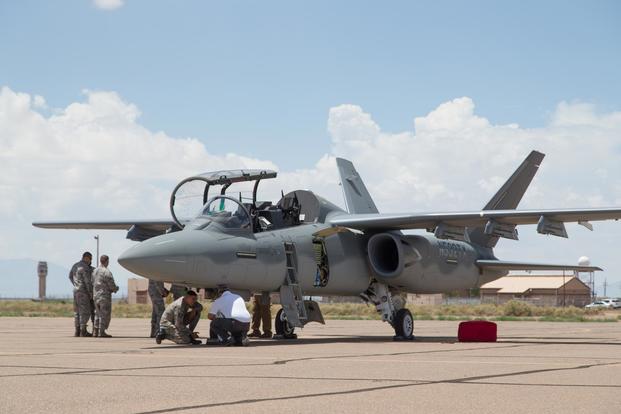The results are in.
The Air Force revealed Thursday it has the findings from the "light attack" aircraft demonstration, which took place in August at Holloman Air Force Base, New Mexico, though it has yet to disclose them.
Members of Congress are eager to hear the verdict.
During a Senate Armed Services Committee hearing on acquisition reform Thursday, senators said they are hopeful the light attack aircraft -- known as OA-X -- procurement strategy may improve how future weapons systems are acquired.
Related content:
- Lawmakers Back $400 Million for Possible A-10 Successor
- From Old Pilots to New Planes, Air Force Chief Talks 'New Ways of Doing Business'
- Plane-Makers Strut Their Stuff in Air Force's 'Light Attack Experiment'
Air Force Secretary Heather Wilson said she had not yet reviewed the report but emphasized the speed of the entire process.
"This is the letter of invitation and four-page set of requirements," she said, holding up the original proposal, which was released to the defense industry on March 8.
"In less than five months, we had four aircraft on the ramp to test at Holloman Air Force Base and, last night, I just got the test report. So in less than 11 months, with five pages, we have tested four aircraft for a potential light attack aircraft for the United States and allies," Wilson said.
Last month, key lawmakers agreed to provide the Air Force with $400 million to explore buying a new light attack aircraft for missions in the Middle East.
Addressing Wilson during Thursday's hearing, Sen Angus King, I-Maine, added, "What you told us about the light attack aircraft and the process is incredibly encouraging, and I hope that you will be able to continue along those lines."
Light Attack's Journey -- So Far
Four aircraft -- AirTractor and L3's AT-802L Longsword; Sierra Nevada and Embraer's A-29 Super Tucano; and Textron and AirLand LLC's Scorpion, as well as their AT-6B Wolverine -- conducted live-fly exercises, combat maneuver scenarios and, on some occasions, weapons drops during the Holloman demonstration.
Air Force Chief of Staff Gen David Goldfein in September told Military.com that the light attack initiative should be viewed as a new way of doing business -- not just a plane, but part of a larger communications system.
OA-X "is actually not about the hardware -- it's about the network," he said, adding he wants the service to train more often with coalition partners -- who may not have high-end fighter aircraft.
Goldfein, who served as the U.S. Air Forces Central Command commander between 2011 and 2013, said, "Is this a way to get more coalition partners into a network to counter violence?
"Can I -- at the same that we're looking at a relatively inexpensive aircraft and sensor package -- can I connect that into a network of sharable information that allows us to better accomplish the strategy as it's been laid out?" he said.
Buying Power
During Thursday's hearing, Sen. David Perdue, a Georgia Republican, highlighted the need for interim solutions, such as light attack, given that the U.S. increasingly seems to require off-the-shelf technologies in times of rising tensions.
"After 30 years of disinvestment and only one major recapitalization, and after 16 years of combat, I believe we have a crisis," he said.
"How do we find quick, low-cost solutions for the battlefield? These high-cost solutions -- flying an F-35 into battlespace where an A-29 might be OK, those types of examples" are what's needed, Perdue said.
Light attack could be a refreshing start, considering the Joint Strike Fighter program -- the Pentagon’s most expensive program to date -- took more than 15 years to produce, between its first design to its date of operation.
Ellen Lord, undersecretary of defense for acquisition, technology and logistics, told the committee hearing that the Defense Department's goal is to shorten major acquisition programs from two-and-a-half years to 12 months.
"Now, that's a first step," she said.
Lord did not say whether that would apply to off-the-shelf experiments such as light attack, but touted OA-X's accomplishments.
The Air Force said it would share the findings of the report when appropriate.
-- Oriana Pawlyk can be reached at oriana.pawlyk@military.com. Follow her on Twitter at @Oriana0214.










